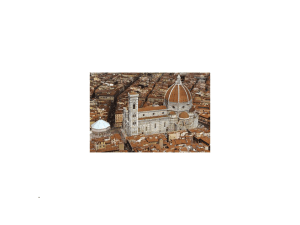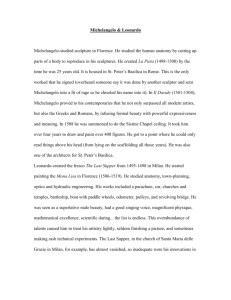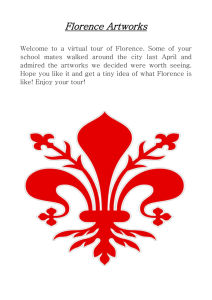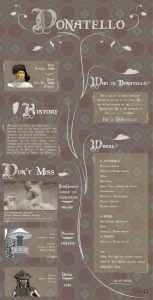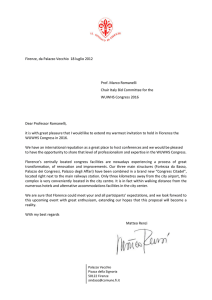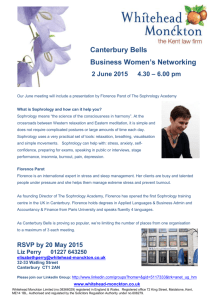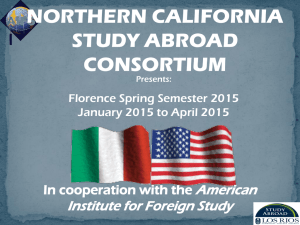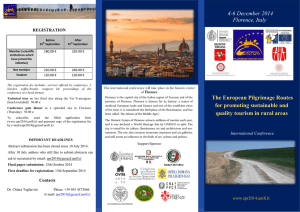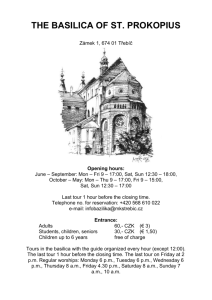Guide To Florence
advertisement
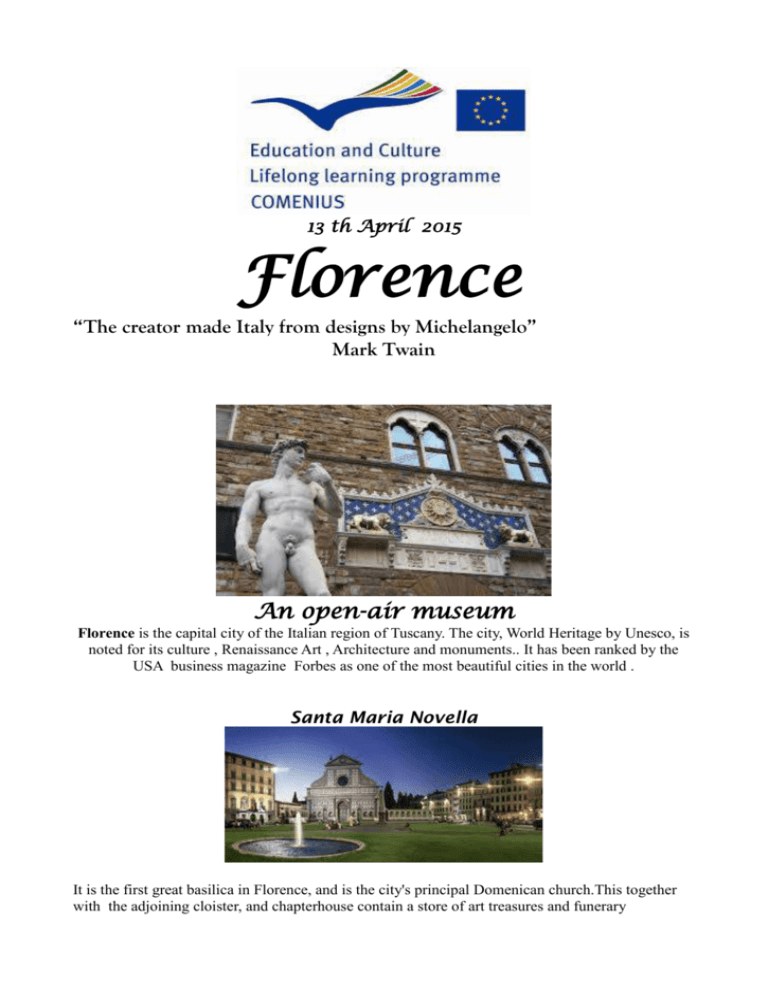
13 th April 2015 Florence “The creator made Italy from designs by Michelangelo” Mark Twain An open-air museum Florence is the capital city of the Italian region of Tuscany. The city, World Heritage by Unesco, is noted for its culture , Renaissance Art , Architecture and monuments.. It has been ranked by the USA business magazine Forbes as one of the most beautiful cities in the world . Santa Maria Novella It is the first great basilica in Florence, and is the city's principal Domenican church.This together with the adjoining cloister, and chapterhouse contain a store of art treasures and funerary monuments. Especially famous are frescoes by masters of Gothic and early renaissanceThey were financed through the generosity of the most important Florentine families, who ensured themselves of funerary chapels on consecrated ground. PIAZZA DEL DUOMO Piazza del Duomo is located in the heart of the historic centre of Florence. Here we can find the Cathedral with the Dome by Brunelleschi, the Giotto's bell tower, the Baptistery,t he Archibishop and Canonici's palace. The west area of this square is called San Giovanni square. Santa Maria del Fiore Basilica Santa Maria del Fiore Basilica is the main church of Florence. The Cathedral was begun in 1296, but it was crowned with Brunelleschi's famous cupola (dome) only in 1436. The exterior of the Basilica consists of marble panels with various green and pink shades and it's renowned for its doors.The Cathedral complex, located in "Piazza del Duomo", includes the Baptistery and Giotto's bell tower. The three buildings have been declared UNESCO World Heritage Site and they cover the historic centre of Florence. They are among the most popular tourist destinations in Tuscany and the Basilica is the fourth church of Europe by size. The only way to see the inside of the dome is to climb its 463 steps (there is no elevator). St. John's Baptistery The octagonal baptistery stands in both Piazza del Duomo and Piazza di San Giovanni, close to Florence Cathedral and Giotto's belltower. The Baptistery is one of the oldest buildings in the city, built between 1059 and 1128 in Romanesque style. The Baptistery is renowned for its artistically important bronze doors with relief sculptures. The Italian poet Dante and many other notable Renaissance figures, including members of the Medici family, were baptized in this baptistery. Basilica di Santa Croce The Basilica di Santa Croce (Holy Cross Basilica) is situated on a square which has been named after the church. It is the largest Franciscan church in Florence and it is one of the greatest examples of Gothic art in Italy. It houses frescoes by Giotto as well as tombs and memorials of famous Tuscans, including Galileo Galilei and Michelangelo. The Neo-Gothic bell tower was added in 1842, after the original was destroyed in 1512 by lightning. The flood in 1966 destroyed much of the basilica and it had to be restored. The Uffizi Gallery The Uffizi Gallery is one of the most important museums in the world. The building of Uffizi was begun by Giorgio Vasari in 1560 for Cosimo I de' Medici so as to accommodate the offices of the Florentine magistrates, hence the name uffizi, "offices". The construction was later continued by Alfonso Parigi and Bernardo Buontalenti and completed in 1581. The internal courtyard is long and narrow. The Palazzo degli Uffizi brought together under one roof the administrative offices, the Tribunal and the Archivio di Stato, the state archive. Over the years, further parts of the palace evolved into a display place for many of the paintings and sculptures collected by the House of Medici or commissioned by them. The works of Botticelli are for many the highlight of the gallery. Not to be missed Botticelli's Venus.The gallery houses paintings from the primitives (Cimabue, Giotto) to the Mannerist period, and is a complete compendium of Renaissance painting. In 1993, a car bomb exploded in Via dei Georgofili and damaged parts of the palace, killing five people. The most severe damage was to the Niobe room and classical sculptures and neoclassical interior of which have been restored, although its frescoes were damaged beyond repair. Ponte Vecchio It was built in 1345 at the narrowest part of the river Arno. It's the only surviving bridge having shops and houses on it. It was originally the domain of blacksmiths, butchers and tanners, who used the river for disposing of waste. Due to the noise and stench they created, they were evicted in 1593 by Duke Ferdinando I and replaced by jewellers and goldsmiths. The eleveted Corridoio Vasariano runs along the eastern side of the bridge above the shops. Giorgio Vasari designed the corridor in 1565 to allow the Medici Family to move from Palazzo Vecchio to Palazzo Pitti without having to mix with public. Via Dei Calziuoli One of the most centrally located and elegant streets in Florence. It's 400 metres long. Before the 15th century, the street was divided into smaller segments which were named after their commercial purpose or the family who lived there. Don't miss the Orsanmichele church. It is situated on the same site where formerly a nunnery lay. The Loggia del mercato nuovo The arcade with its wide Renaissance-style arches was built in the 16th century to house the silk and precious objects collected from trade and is still today a lively marketplace crammed with stalls of souvenir sellers. The place constantly attracts flocks of tourists due to the famous fountain of the Piglet, on its southern side. The fountain is not of a piglet but of a wild boar, and is a copy of the Greek marble original on display in the Uffizi Galleries. Classe 5G IIS ORIO VERGANI FERRARA a.s 2014-5
